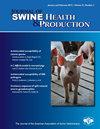饮水者与保育猪的比例:2天内的饮水行为、攻击性和饮水者的位置偏好
IF 0.7
4区 农林科学
Q3 Agricultural and Biological Sciences
引用次数: 2
摘要
目的:确定饮水者数量(1、2或3个饮水者/围栏)对7周龄育肥猪饮水者到访频率和持续时间、饮水者附近的攻击性互动、饮水者位置偏好和水分消失的影响。材料和方法:将225只7周大、编号独特的金边猪商业化饲养(25只金边猪/只)。将三个处理与3个笔/处理进行比较:1个饮酒者(处理1)、2个饮者(处理2)和3个饮酒者。在每个饮酒者身上放置一台摄像机,连续两天记录早上7:00到下午12:59之间的行为。此外,每条水管线上都安装了1个水表,以记录水的消失情况。结果:与其他2个治疗组相比,治疗组3的猪拜访了饮酒者,并在饮酒者处呆了更多的时间(P=0.02)。与其他2组相比,在上午7:00至7:59之间,治疗组1的猪在饮酒者附近的攻击性互动持续时间更长(P=0.02,猪在小巷附近喂食器对面的饮水器处停留的时间最少(P<.001)。总水分消失量在处理1中最大,在处理2中最小。影响:在研究条件下,3名饮酒者增加了拜访次数和与饮酒者相处的时间,但没有增加攻击性互动。当提供3个饮酒者时,猪表现出位置偏好。结果可以告知生产者在围栏中放置水。本文章由计算机程序翻译,如有差异,请以英文原文为准。
Drinker to nursery pig ratio: Drinking behavior, aggression, and drinker location preference over 2 days
Objective: Determine the effect of drinker number (1, 2, or 3 drinkers/pen) on the frequency and duration for drinker visits, aggressive interactions in the drinker vicinity, drinker location preference, and water disappearance for 7-week-old nursery pigs. Materials and methods: Two hundred twenty-five, 7-week-old gilts identified with unique numbers were commercially housed (25 gilts/pen). Three treatments were compared with 3 pens/treatment: 1 drinker (treatment 1), 2 drinkers (treatment 2), and 3 drinkers (treatment 3). One camera was positioned over each drinker to record behavior between 7:00 am and 12:59 pm over 2 consecutive days. In addition, 1 water meter was installed on each water line to record water disappearance. Results: Pigs in treatment 3 visited and spent more time at the drinkers compared to the other 2 treatments (P = .02). Pigs in treatment 1 had more and longer duration of aggressive interactions in the drinker vicinity compared to the other 2 treatments between 7:00 am to 7:59 am (P = .02). When offered 3 drinkers, pigs spent the least amount of time at the drinker across from the feeder near the alleyway (P < .001). Total water disappearance was greatest for treatment 1 and least for treatment 2. Implications: Under study conditions, 3 drinkers increased visits and time at drinkers without increasing aggressive interactions. Pigs exhibited location preference when offered 3 drinkers. Results can inform producers on water placement in pens.
求助全文
通过发布文献求助,成功后即可免费获取论文全文。
去求助
来源期刊
CiteScore
1.80
自引率
0.00%
发文量
29
审稿时长
>36 weeks
期刊介绍:
The Journal of Swine Health & Production (JSHAP) is an open-access and peer-reviewed journal published by the American Association of Swine Veterinarians (AASV) since 1993. The aim of the journal is the timely publication of peer-reviewed papers with a scope that encompasses the many domains of applied swine health and production, including the diagnosis, treatment, management, prevention and eradication of swine diseases, welfare & behavior, nutrition, public health, epidemiology, food safety, biosecurity, pharmaceuticals, antimicrobial use and resistance, reproduction, growth, systems flow, economics, and facility design. The journal provides a platform for researchers, veterinary practitioners, academics, and students to share their work with an international audience. The journal publishes information that contains an applied and practical focus and presents scientific information that is accessible to the busy veterinary practitioner as well as to the research and academic community. Hence, manuscripts with an applied focus are considered for publication, and the journal publishes original research, brief communications, case reports/series, literature reviews, commentaries, diagnostic notes, production tools, and practice tips. All manuscripts submitted to the Journal of Swine Health & Production are peer-reviewed.

 求助内容:
求助内容: 应助结果提醒方式:
应助结果提醒方式:


